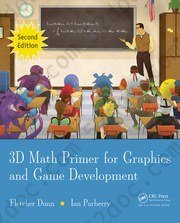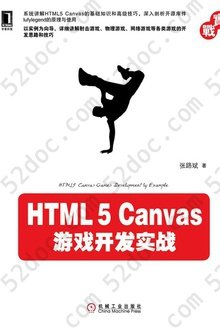注重体验与质量的电子书资源下载网站
分类于: 互联网 职场办公
简介

3D Math Primer for Graphics and Game Development, 2nd Edition 豆 9.3分
资源最后更新于 2020-08-23 08:23:11
作者:Fletcher Dunn
出版社:A K Peters/CRC Press
出版日期:2011-01
ISBN:9781568817231
文件格式: pdf
标签: 数学 图形学 游戏开发 计算机图形学 3D 计算机科学 游戏 Graphics
简介· · · · · ·
This engaging book presents the essential mathematics needed to describe, simulate, and render a 3D world. Reflecting both academic and in-the-trenches practical experience, the authors teach you how to describe objects and their positions, orientations, and trajectories in 3D using mathematics. The text provides an introduction to mathematics for game designers, including the ...
目录
Cartesian Coordinate Systems
1D Mathematics
2D Cartesian Space
3D Cartesian Space
Odds and ends
Vectors
Vector — mathematical definition and other boring stuff
Vector — a geometric definition
Specifying vectors using Cartesian coordinates
Vectors vs. points
Negating a vector
Vector multiplication by a scalar
Vector addition and subtraction
Vector magnitude (length)
Unit vectors
The distance formula
Vector dot product
Vector cross product
Linear algebra identities
Multiple Coordinate Spaces
Why multiple coordinate spaces?
Some useful coordinate spaces
Coordinate space transformations
Nested coordinate spaces
In defense of upright space
Introduction to Matrices
Matrix — a mathematical definition
Matrix — a geometric interpretation
The bigger picture of linear algebra
Matrices and Linear Transformations
Rotation
Scale
Orthographic projection
Reection
Shearing
Combining transformations
Classes of transformations
More on Matrices
Determinant of a matrix
Inverse of a matrix
Orthogonal matrices
4 x 4 homogeneous matrices
4 x 4 matrices and perspective projection
Polar Coordinate Systems
2D Polar Space
Why would anybody use Polar coordinates?
3D Polar Space
Using polar coordinates to specify vectors
Rotation in Three Dimensions
What exactly is "orientation?"
Matrix form
Euler angles
Axis-angle and exponential map representations
Quaternions
Comparison of methods
Converting between representations
Geometric Primitives
Representation techniques
Lines and rays
Spheres and circles
Bounding boxes
Planes
Triangles
Polygons
Mathematical Topics from 3D Graphics
How graphics works
Viewing in 3D
Coordinate spaces
Polygon meshes
Texture mapping
The standard local lighting model
Light sources
Skeletal animation
Bump mapping
The real-time graphics pipeline
Some HLSL examples
Further reading
Mechanics 1: Linear Kinematics and Calculus
Overview and other expectation-reducing remarks
Basic quantities and units
Average velocity
Instantaneous velocity and the derivative
Acceleration
Motion under constant acceleration
Acceleration and the integral
Uniform circular motion
Mechanics 2: Linear and Rotational Dynamics
Newton's three laws
Some simple force laws
Momentum
Impulsive forces and collisions
Rotational dynamics
Real-time rigid body simulators
Suggested reading
Curves in 3D
Parametric polynomial curves
Polynomial interpolation
Hermite curves
Bezier curves
Subdivision
Splines
Hermite and Bezier splines
Continuity
Automatic tangent control
Afterword
What next?
Appendix A: Geometric Tests
Appendix B: Answers to the Exercises
Bibliography
Index
1D Mathematics
2D Cartesian Space
3D Cartesian Space
Odds and ends
Vectors
Vector — mathematical definition and other boring stuff
Vector — a geometric definition
Specifying vectors using Cartesian coordinates
Vectors vs. points
Negating a vector
Vector multiplication by a scalar
Vector addition and subtraction
Vector magnitude (length)
Unit vectors
The distance formula
Vector dot product
Vector cross product
Linear algebra identities
Multiple Coordinate Spaces
Why multiple coordinate spaces?
Some useful coordinate spaces
Coordinate space transformations
Nested coordinate spaces
In defense of upright space
Introduction to Matrices
Matrix — a mathematical definition
Matrix — a geometric interpretation
The bigger picture of linear algebra
Matrices and Linear Transformations
Rotation
Scale
Orthographic projection
Reection
Shearing
Combining transformations
Classes of transformations
More on Matrices
Determinant of a matrix
Inverse of a matrix
Orthogonal matrices
4 x 4 homogeneous matrices
4 x 4 matrices and perspective projection
Polar Coordinate Systems
2D Polar Space
Why would anybody use Polar coordinates?
3D Polar Space
Using polar coordinates to specify vectors
Rotation in Three Dimensions
What exactly is "orientation?"
Matrix form
Euler angles
Axis-angle and exponential map representations
Quaternions
Comparison of methods
Converting between representations
Geometric Primitives
Representation techniques
Lines and rays
Spheres and circles
Bounding boxes
Planes
Triangles
Polygons
Mathematical Topics from 3D Graphics
How graphics works
Viewing in 3D
Coordinate spaces
Polygon meshes
Texture mapping
The standard local lighting model
Light sources
Skeletal animation
Bump mapping
The real-time graphics pipeline
Some HLSL examples
Further reading
Mechanics 1: Linear Kinematics and Calculus
Overview and other expectation-reducing remarks
Basic quantities and units
Average velocity
Instantaneous velocity and the derivative
Acceleration
Motion under constant acceleration
Acceleration and the integral
Uniform circular motion
Mechanics 2: Linear and Rotational Dynamics
Newton's three laws
Some simple force laws
Momentum
Impulsive forces and collisions
Rotational dynamics
Real-time rigid body simulators
Suggested reading
Curves in 3D
Parametric polynomial curves
Polynomial interpolation
Hermite curves
Bezier curves
Subdivision
Splines
Hermite and Bezier splines
Continuity
Automatic tangent control
Afterword
What next?
Appendix A: Geometric Tests
Appendix B: Answers to the Exercises
Bibliography
Index







